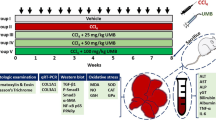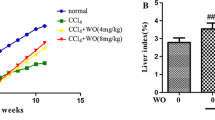Abstract
6-Gingerol (Gin) is known to possess hepatoprotective effects. Liver fibrosis is a major health concern that results in significant morbidity and mortality. There is no FDA-approved medication for liver fibrosis. The present work aimed at exploring the beneficial effects of Gin against liver fibrosis in rats. Experimental fibrosis was induced by challenging animals with CCl4 for 6 weeks. Gin significantly ameliorated the increase in serum alanine aminotransferase (ALT) and aspartate aminotransferase (AST) activities, albumin, total cholesterol (TC) and triglyceride (TG) concentrations, and liver index. These effects were confirmed by light and electron microscopic examinations. The antifibrotic effects were confirmed by examining Masson trichrome-stained liver sections which indicated reduced collagen deposition in Gin-treated animals. Further, Gin administration hampered alpha-smooth muscle actin (α-SMA) expression and significantly reduced hepatic content of transforming growth factor-beta (TGF-β). Also, Gin elicited profound antioxidant actions as indicated by preventing reduced glutathione (GSH) depletion and lipid peroxide accumulation. The observed antifibrotic activities involved decreased production of nuclear factor κB (NF-κB), tumor necrosis factor alpha (TNF-α), expression of toll-like receptor 4 (TLR4), intercellular adhesion molecule (ICAM), and vascular cell adhesion molecule (VCAM). Involvement of Gin anti-inflammatory activity was verified by the decreased expression of inducible nitric oxide synthase (iNOS) and cyclooxygenase-2 (COX-2) in livers of animals treated with Gin. Thus, it can be concluded that Gin protects against CCl4-induced liver fibrosis in rats. This can be ascribed, at least partly, to its antioxidant, anti-inflammatory effects as well as the inhibition of NF-κB/TLR-4 expression.








Similar content being viewed by others
References
Ahn SI, Lee JK, Youn HS (2009) Inhibition of homodimerization of toll-like receptor 4 by 6-shogaol. Mol Cell 27(2):211–215. doi:10.1007/s10059-009-0026-y
Ajayi BO, Adedara IA, Farombi EO (2015) Pharmacological activity of 6-gingerol in dextran sulphate sodium-induced ulcerative colitis in BALB/c mice. Phytother Res 29(4):566–572. doi:10.1002/ptr.5286
Akira S, Takeda K (2004) Toll-like receptor signaling. Nat Rev Immunol 4(7):499–511
Bataller R, Brenner DA (2005) Liver fibrosis. J Clin Invest 115(2):209–218
Boll M, Weber LW, Becker E, Stampfl A (2001) Mechanism of carbon tetrachloride-induced hepatotoxicity. Hepatocellular damage by reactive carbon tetrachloride metabolites. Z Naturforsch C 56(7–8):649–659
Friedman SL (1993) Seminars in medicine of the Beth Israel Hospital, Boston. The cellular basis of hepatic fibrosis. Mechanisms and treatment strategies. N Engl J Med 328(25):1828–1835.
Greenwel P, Domínguez-Rosales JA, Mavi G, Rivas-Estilla AM, Rojkind M (2000) Hydrogen peroxide: a link between acetaldehyde-elicited alpha1(I) collagen gene up-regulation and oxidative stress in mouse hepatic stellate cells. Hepatology 31(1):109–116
Guh JH, Ko FN, Jong TT, Teng CM (1995) Antiplatelet effect of gingerol isolated from Zingiber officinale. J Pharm Pharmacol 47(4):329–332
Johnston DE, Kroening C (1998) Mechanism of early carbon tetrachloride toxicity in cultured rat hepatocytes. Pharmacol Toxicol 83(6):231–239
Kim JK, Kim Y, Na KM, Surh YJ, Kim TY (2007) [6]-Gingerol prevents UVB-induced ROS production and COX-2 expression in vitro and in vivo. Free Radic Res 41(5):603–614
Kuhad A, Tirkey N, Pilkhwal S, Chopra K (2006) 6-Gingerol prevents cisplatin-induced acute renal failure in rats. Biofactors 26(3):189–200
Lee C, Park GH, Kim CY, Jang JH (2011) [6]-Gingerol attenuates β-amyloid-induced oxidative cell death via fortifying cellular antioxidant defense system. Food Chem Toxicol 49(6):1261–1269. doi:10.1016/j.fct.2011.03.005
Lee HY, Park SH, Lee M, Kim HJ, Ryu SY, Kim ND, Hwang BY, Hong JT, Han SB, Kim Y (2012) 1-Dehydro-[10]-gingerdione from ginger inhibits IKKβ activity for NF-κB activation and suppresses NF-κB-regulated expression of inflammatory genes. Br J Pharmacol 167(1):128–140. doi:10.1111/j.1476-5381.2012.01980.x
Li XH, McGrath KC, Tran VH, Li YM, Duke CC, Roufogalis BD, Heather AK (2013a) Attenuation of proinflammatory responses by S-[6]-gingerol via inhibition of ROS/NF-Kappa B/COX2 activation in HuH7 cells. Evid Based Complement Alternat Med 2013:146142. doi:10.1155/2013/146142
Li Y, Tran VH, Koolaji N, Duke C, Roufogalis BD (2013b) (S)-[6]-Gingerol enhances glucose uptake in L6 myotubes by activation of AMPK in response to [Ca2+]i. J Pharm Pharm Sci 16(2):304–312
Ma S, Zhang S, Duan W, Wang W (2009) An enantioselective synthesis of (+)-(S)-[n]-gingerols via the l-proline-catalyzed aldol reaction. Bioorg Med Chem Lett 19(14):3909–3911. doi:10.1016/j.bmcl.2009.03.081
Mihara M, Uchiyama M (1978) Determination of malonaldehyde precursor in tissues by thiobarbituric acid test. Anal Biochem 86(1):271–278
Oyagbemi AA, Saba AB, Azeez OI (2010) Molecular targets of [6]-gingerol: its potential roles in cancer chemoprevention. Biofactors 36(3):169–178. doi:10.1002/biof.78
Park SJ, Lee MY, Son BS, Youn HS (2009) TBK1-targeted suppression of TRIF-dependent signaling pathway of Toll-like receptors by 6-shogaol, an active component of ginger. Biosci Biotechnol Biochem 73(7):1474–1478
Park SH, Kyeong MS, Hwang Y, Ryu SY, Han SB, Kim Y (2012) Inhibition of LPS binding to MD-2 co-receptor for suppressing TLR4-mediated expression of inflammatory cytokine by 1-dehydro-10-gingerdione from dietary ginger. Biochem Biophys Res Commun 419(4):735–740. doi:10.1016/j.bbrc.2012.02.091
Pinzani M, Macias-Barragan J (2010) Update on the pathophysiology of liver fibrosis. Exp Rev Gastroenterol Hepatol 4(4):459–472. doi:10.1586/egh.10.47
Popov Y, Schuppan D (2009) Targeting liver fibrosis: strategies for development and validation of antifibrotic therapies. Hepatology 50(4):1294–1306. doi:10.1002/hep.23123
Povero D, Busletta C, Novo E, di Bonzo LV, Cannito S, Paternostro C, Parola M (2010) Liver fibrosis: a dynamic and potentially reversible process. Histol Histopathol 25(8):1075–1091
Puche JE, Saiman Y, Friedman SL (2013) Hepatic stellate cells and liver fibrosis. Comp Physiol 3(4):1473–1492. doi:10.1002/cphy.c120035
Racanelli V, Rehermann B (2006) The liver as an immunological organ. Hepatology 43(2 Suppl 1):S54–S62
Reeves HL, Friedman SL (2002) Activation of hepatic stellate cells—a key issue in liver fibrosis. Front Biosci 7:d808–d826
Rodrigues FA, Prata MM, Oliveira IC, Alves NT, Freitas RE, Monteiro HS, Silva JA, Vieira PC, Viana DA, Libório AB, Havt A (2014) Gingerol fraction from Zingiber officinale protects against gentamicin-induced nephrotoxicity. Antimicrob Agents Chemother 58(4):1872–1878. doi:10.1128/AAC.02431-13
Sabina EP, Pragasam SJ, Kumar S, Rasool M (2011) 6-gingerol, an active ingredient of ginger, protects acetaminophen-induced hepatotoxicity in mice. Zhong Xi Yi Jie He Xue Bao 9(11):1264–1269
Sánchez-Valle V, Chávez-Tapia NC, Uribe M, Méndez-Sánchez N (2012) Role of oxidative stress and molecular changes in liver fibrosis: a review. Curr Med Chem 19(28):4850–4860
Shrivastava S (2015) The influence of gingerol treatment on aluminum toxicity in rats. J Environ Pathol Toxicol Oncol 34(1):11–21
Soares JB, Pimentel-Nunes P, Afonso L, Rolanda C, Lopes P, Roncon-Albuquerque R Jr, Gonçalves N, Boal-Carvalho I, Pardal F, Lopes S, Macedo G, Lara-Santos L, Henrique R, Moreira-Dias L, Gonçalves R, Dinis-Ribeiro M, Leite-Moreira AF (2012) Increased hepatic expression of TLR2 and TLR4 in the hepatic inflammation-fibrosis-carcinoma sequence. Innate Immun 18(5):700–708
Son MJ, Miura Y, Yagasaki K (2015) Mechanisms for antidiabetic effect of gingerol in cultured cells and obese diabetic model mice. Cytotechnology 67(4):641–652. doi:10.1007/s10616-014-9730-3
Spitzer JA, Zheng M, Kolls JK, Vande Stouwe C, Spitzer JJ (2002) Ethanol and LPS modulate NF-kappaB activation, inducible NO synthase and COX-2 gene expression in rat liver cells in vivo. Front Biosci 7:a99–a108
Tripathi S, Maier KG, Bruch D, Kittur DS (2007) Effect of 6-gingerol on pro-inflammatory cytokine production and costimulatory molecule expression in murine peritoneal macrophages. J Surg Res 138(2):209–213
Tzeng TF, Liou SS, Chang CJ, Liu IM (2015) 6-gingerol protects against nutritional steatohepatitis by regulating key genes related to inflammation and lipid metabolism. Nutrients 7(2):999–1020. doi:10.3390/nu7020999
Yamamoto M, Takeda K (2010) Current views of toll-like receptor signaling pathways. Gastroenterol Res Pract 2010:240365. doi:10.1155/2010/240365
Zhao X, Zmijewski JW, Lorne E, Liu G, Park YJ, Tsuruta Y, Abraham E (2008) Activation of AMPK attenuates neutrophil proinflammatory activity and decreases the severity of acute lung injury. Am J Physiol Lung Cell Mol Physiol 295(3):L497–L504. doi:10.1152/ajplung.90210.2008
Acknowledgments
This project was funded by the Deanship of Scientific Research (DSR), King Abdulaziz University, Jeddah, under grant no. 30/34/RG. The authors, therefore, acknowledge with thanks the DSR technical and financial support.
MA, AMA, AN, OA, and ABA participated in the biochemical and immunohistochemical studies. AN and MA performed the histopathological studies. AE and HA prepared, purified, and characterized 6-gingerol. AE, HA, and AN performed data analysis. All authors participated in writing the manuscript. OA and ABA prepared the manuscript for final submission.
Author information
Authors and Affiliations
Corresponding author
Ethics declarations
Animal handling and experimental protocol were approved by the Unit of Biomedical Ethics, Faculty of Medicine, King Abdulaziz University (Reference No. 157–14).
Conflict of interest
The authors declare that they have no competing interests.
Rights and permissions
About this article
Cite this article
Algandaby, M.M., El-halawany, A.M., Abdallah, H.M. et al. Gingerol protects against experimental liver fibrosis in rats via suppression of pro-inflammatory and profibrogenic mediators. Naunyn-Schmiedeberg's Arch Pharmacol 389, 419–428 (2016). https://doi.org/10.1007/s00210-016-1210-1
Received:
Accepted:
Published:
Issue Date:
DOI: https://doi.org/10.1007/s00210-016-1210-1




